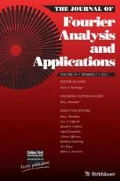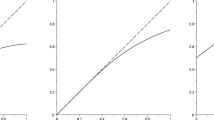Abstract
The operator that first truncates to a neighborhood of the origin in the spatial domain then truncates to a neighborhood of the origin in the spectral domain is investigated in the case of Boolean cubes. This operator is self adjoint on the space of functions spanned by the Laplacian eigenvectors corresponding to small eigenvalues. The eigenspaces of this iterated projection operator are studied through reduced matrices based on certain invariant subspaces. They are shown to depend fundamentally on the neighborhood structure of the cube defined in terms of Hamming distance.




Similar content being viewed by others
References
Alon, N., Dinur, I., Friedgut, E., Sudakov, B.: Graph products, Fourier analysis and spectral techniques. Geom. Funct. Anal. 14(5), 913–940 (2004)
Amadei, M., Manzoli, U., Merani, M.L.: On the assignment of Walsh and quasi-orthogonal codes in a multicarrier DS-CDMA system with multiple classes of users, Global Telecommunications Conference, 2002. GLOBECOM ’02. IEEE, vol. 1, pp. 841–845 (2002)
Bernasconi, A., Codenotti, B.: Spectral analysis of Boolean functions as a graph eigenvalue problem. IEEE Trans. Comput. 48(3), 345–351 (1999)
Chen, S., Varma, R., Sandryhaila, A., Kovačević, J.: Discrete signal processing on graphs: sampling theory. IEEE Trans. Signal Process. 63(24), 6510–6523 (2015)
de Wolf, R.: A brief introduction to Fourier analysis on the Boolean cube. Theory Comput. Grad. Surv. 1, 1–20 (2008)
Grünbaum, F.A.: Eigenvectors of a Toeplitz matrix: Discrete version of the prolate spheroidal wave functions. SIAM J. Algebraic Discret. Methods 2(2), 136–141 (1981)
Grünbaum, F.A.: Toeplitz matrices commuting with tridiagonal matrices. Linear Algebra Appl. 40, 25–36 (1981)
Gur, T., Tamuz, O.: Testing Booleanity and the uncertainty principle. Chic. J. Theoret. Comput. Sci. 14, 14 (2013)
Heil, C.: What is \(\ldots \) a frame? Notices Am. Math. Soc. 60(6), 748–750 (2013)
Hogan, J.A., Lakey, J.D.: Duration and Bandwidth Limiting. Prolate Functions, Sampling, and Applications. Birkhäuser, Boston (2012)
Hogan, J.A., Lakey, J.D.: An analogue of Slepian vectors on Boolean hypercubes. J. Fourier Anal. Appl. 25(4), 2004–2020 (2019)
Hogan, J.A., Lakey, J.D.: Some invariant spaces on products of short cycles. Arxiv e-prints arXiv:2012.11752 (2020)
Hogan, J.A., Lakey, J.D.: Spatio-spectral limiting on redundant cubes: a case study, Excursions in Harmonic Analysis, Volume 6: In Honor of John Benedetto’s 80th Birthday (M. Hirn, S. Li, K. Okoudjou, S. Saliani, and O. Yilmaz, eds.), Springer Nature, to appear (2020)
Huang, Z., Chan, N.H.: Walsh Fourier transform of locally stationary time series. J. Time Ser. Anal. 41(2), 312–340 (2020)
Kushilevitz, E., Mansour, Y.: Learning decision trees using the Fourier spectrum. SIAM J. Comput. 22(6), 1331–1348 (1993)
Landau, H.J., Pollak, H.O.: Prolate spheroidal wave functions, Fourier analysis and uncertainty. II. Bell Syst. Tech. J. 40, 65–84 (1961)
Landau, H.J., Widom, H.: Eigenvalue distribution of time and frequency limiting. J. Math. Anal. Appl. 77, 469–481 (1980)
Leus, G., Segarra, S., Ribeiro, A., Marques, A.G.: The dual graph shift operator: Identifying the support of the frequency domain, Arxiv e-prints arXiv:1705.08987 (2017)
Linial, N., Mansour, Y., Nisan, N.: Constant depth circuits, Fourier transform, and learnability. J. ACM 40(3), 607–620 (1993)
Mitton, M.: On the Walsh-Fourier analysis of Boolean functions. J. Discret. Math. Sci. Cryptogr. 9(3), 429–439 (2006)
Morettin, P.A.: Walsh-Fourier analysis and its statistical applications: comment. J. Am. Stat. Assoc. 86(414), 482–483 (1991)
Mossel, E., O’Donnell, R.: Special issue on analysis of Boolean functions: guest editors’ foreword. Theory Comput. 9, 579–585 (2013)
Moysiadis, T., Fokianos, K.: On locally dyadic stationary processes. IEEE Trans. Inf. Theory 63(8), 4829–4837 (2017)
O’Donnell, R.: Analysis of Boolean Functions. Cambridge University Press, New York (2014)
Shi, J., Moura, J.M.F.: Graph signal processing: Modulation, convolution, and sampling. Arxiv preprint arXiv:1912.06762 (2019)
Slepian, D.: Prolate spheroidal wave functions, Fourier analysis and uncertainty. IV. Extensions to many dimensions; generalized prolate spheroidal functions. Bell Syst. Tech. J. 43, 3009–3057 (1964)
Slepian, D.: Prolate spheroidal wave functions, Fourier analysis, and uncertainty. V—The discrete case. Bell Syst. Tech. J. 57, 1371–1430 (1978)
Slepian, D., Pollak, H.O.: Prolate spheroidal wave functions, Fourier analysis and uncertainty. I. Bell Syst. Tech. J. 40, 43–63 (1961)
Stobbe, P., Krause, A.: Learning Fourier sparse set functions. J. Mach. Learn. Res. 22, 1125–1133 (2012)
Stoffer, D.S.: Walsh-Fourier analysis and its statistical applications. J. Am. Stat. Assoc. 86(414), 461–479 (1991)
Thomson, D.J.: Spectrum estimation and harmonic analysis. Proc. IEEE 70, 1055–1096 (1982)
Tsitsvero, M., Barbarossa, S., Di Lorenzo, P.: Signals on graphs: Uncertainty principle and sampling. IEEE Trans. Signal Process. 64, 4845–4860 (2016)
Wendler, C., Amrollahi, A., Seifert, B., Krause, A., Püschel, M.: Learning set functions that are sparse in non-orthogonal Fourier bases. Arxiv e-prints arXiv:2010.00439 (2020)
Xu, W.Y., Chamzas, C.: On the periodic discrete prolate spheroidal sequences. SIAM J. Appl. Math. 44, 1210–1217 (1984)
Zemen, T., Mecklenbräuker, C.F.: Time-variant channel estimation using discrete prolate spheroidal sequences. IEEE Trans. Signal Process. 53(9), 3597–3607 (2005)
Author information
Authors and Affiliations
Corresponding author
Additional information
Communicated by Hans G. Feichtinger.
Publisher's Note
Springer Nature remains neutral with regard to jurisdictional claims in published maps and institutional affiliations.
Appendix: Proofs of Some Ancillary Facts
Appendix: Proofs of Some Ancillary Facts
1.1 Projection Onto \({\mathcal {W}}_r\)
Theorem 1 can be used to compute the projection of \(\ell ^2(\Sigma _r)\) onto \({{\mathcal {W}}}_r\), the orthogonal complement of \(A_+(\ell ^2(\Sigma _{r-1}))\) in \(\ell ^2(\Sigma _r)\). The iterative procedure for achieving this is detailed in Proposition 7 below.
Lemma 4
Suppose \(f_0\) is the vertex function given by \(f_0(S)=\delta _{S,\emptyset }\), i.e., \(f_0(\emptyset )=1\) while \(f_0(S)=0\) for all \(S\ne \emptyset \). Then for all \(0\le r\le N\),
Proof
We have already seen that \(A_+(\ell ^2(\Sigma _r))\subset \ell ^2(\Sigma _{r+1})\), so that \(A_+f_0\in \ell ^2(\Sigma _1)\). Note that if \(R\in \Sigma _1\),
so that (A.1) is verified when \(r=1\). Suppose now that (A.1) holds for \(r=\ell \). Then \(A_+^{\ell +1}f_0(R)=0\) if \(R\notin \Sigma _{\ell +1}\) while if \(R\in \Sigma _{\ell +1}\), we have
i.e., (A.1) is verified for \(r=\ell +1\). We conclude that (A.1) holds for all \(0\le r\le N\). \(\square \)
Proposition 7
Let \(f\in \ell ^2(\Sigma _r)\) \((r<N/2)\). By (3.2), f has a unique decomposition of the form
The vertex functions \(\{g_\ell \}_{\ell =0}^r\) are given iteratively by:
-
(i)
\(g_0=\dfrac{A_-^rf}{n(0,r)}\);
-
(ii)
\(g_\ell =\dfrac{A_-^{r-\ell }\big [f-\sum _{j=0}^{\ell -1}A_+^{r-j}g_j\big ]}{n(\ell , r-\ell )}\) \((1\le \ell \le r)\)
where the constants \(n(r,\ell )\) are defined in (3.7).
Proof
An application of \(A_-^r\) to both sides of (A.2) yields
where we have applied Corollary 1 and the fact that \(A_-g_j=0\) for all j. Dividing both sides of this equation by n(0, r) gives definition (i) of \(g_0\). Similarly, applying \(A_-^{r-1}\) to both sides of (A.2) yields
so that \(g_1=\dfrac{A_-^{r-1}(f-A_+^rg_0)}{n(1,r-1)}\), thus verifying (ii) in the case \(\ell =1\). Now suppose that \(g_0,g_1,\ldots ,g_{\ell -1}\) have been determined. Applying \(A_-^{r-\ell }\) to both sides of (A.2) gives
Note that \(n(\ell ,r-\ell )\ne 0\) for \(\ell \le r<N/2\). Rearranging this equation gives (ii). This proves the result. \(\square \)
Remark
The projections must be computed iteratively starting with the innermost projections in order to ensure that components extracted at each step are orthogonal to components from smaller spheres.
1.2 Proof of Proposition 2
We restate Proposition 2 as follows.
Proposition 8
Let \(0\le r<s<N/2\). Let \(f_r=\sum _{\ell =0}^{N-2r} c_k A_+^k g_r\in {\mathcal {V}}_r\) and \( f_s=\sum _{\ell =0}^{N-2s} d_k A_+^k g_s\in {\mathcal {V}}_s\). Then \(f_r\) and \(f_s\) are orthogonal.
Proof
It suffices to show that the restrictions of \(f_r\) and \(f_s\) to any Hamming sphere \(\Sigma _\rho \) are orthogonal. This is automatically true if \(\rho <s\) or \(\rho >N-s\) since \(f_s=0\) on such spheres. If \(s\le \rho \le N-s\) then \(f_r|_{\Sigma _\rho } =c_{\rho -r} A_+^{\rho -r}g_r\) and \(f_s|_{\Sigma _\rho } =d_{\rho -s} A_+^{\rho -s}g_s\). Therefore
by virtue of (3.2). \(\square \)
1.3 Proof of Proposition 1
Lemma 5
If \(h\in \ell ^2(\Sigma _r)\setminus {\mathcal {W}}_r\), \(0<r<N/2\), then \(A_+A_- h\ne 0\).
Proof
Theorem 1 implies that \(A_+\) is injective on \(\ell ^2(\Sigma _{r-1})\) (\(1<r<N/2\)). Since \(A_-h\in \ell ^2(\Sigma _{r-1})\setminus \{0\}\), the lemma follows. \(\square \)
Proof of Proposition 1
Consider the involution \(\widetilde{g}(S)=g(\widetilde{S})\) where \(\widetilde{S}\) is the complement of S in \(\{1,\ldots N\}\). This involution is an isomorphism between \(\ell ^2(\Sigma _r)\) and \(\ell ^2(\Sigma _{N-r})\). In addition, \((A_-g)^{\sim }=A_+ \widetilde{g}\). To see this, if \({b'}\in S\) then \((A_+ \widetilde{g})(\widetilde{S}\cup {b'})=\sum _{b\in (\widetilde{S}\cup {b'})} \widetilde{g}((\widetilde{S}\cup {b'})\setminus b)= \sum _{b\notin (S\setminus {b'})}g((S\setminus {b'})\cup b)=(A_-g)(S\setminus {b'})=(A_-g)^{\sim }(\widetilde{S}\cup {b'})\).
By Theorem 1, if \(g\in {\mathcal {W}}_r\) then \(A_-A_+^{N-2r+1}g=0\). We claim that, in fact, \(A_+^{N-2r+1}g=0\). Set \(\widetilde{u}= A_+^{N-2r}g\). The claim then is that \(A_+\widetilde{u}=0\), that is, \(A_-u=0\), so \(u\in {\mathcal {W}}_r\). Suppose not. Since \(\widetilde{u}\in \ell ^2(\Sigma _{N-r})\) and \({u}\in \ell ^2(\Sigma _{r})\), u has a unique orthogonal decomposition \(u=u_1+h\) where \(u_1\in {\mathcal {W}}_r\) and \(h=A_+u_2\) for some nonzero \(u_2\in \ell ^2(\Sigma _{r-1})\). The condition \(A_-A_+^{N-2r+1}g=0\) becomes \(A_-A_+ \widetilde{h}=0\). Involuting gives \(A_+A_-h=0\) which contradicts Lemma 5. This contradiction proves Proposition 1. \(\square \)
Rights and permissions
About this article
Cite this article
Hogan, J.A., Lakey, J.D. Spatio-Spectral Limiting on Boolean Cubes. J Fourier Anal Appl 27, 40 (2021). https://doi.org/10.1007/s00041-021-09845-y
Received:
Revised:
Accepted:
Published:
DOI: https://doi.org/10.1007/s00041-021-09845-y



